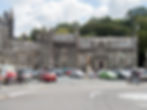Tavistock Guildhall - “The least possible delay”
- Sep 6, 2018
- 3 min read
Updated: Jan 19, 2019
This piece was written by the late Gerry Woodcock and first published in Tavistock History Society Newsletter of Spring 2014. It is reproduced here with the kind permission of Norma Woodcock.
It is a common complaint that parliament is ineffective as a means of getting things done. The House of Commons, it is frequently argued, is nimble when it comes to passing resolutions, setting up enquiries and issuing notices and questionnaires, but is slow when it comes to listening to complaints and remedying them. In fairness to our legislators, it is not always so.
On 19 March 1845 the Commons passed a resolution calling for “a return from the clerk of each Petty Sessions in England and Wales, of the description of the building or place in which the Justices of the Petty sessions hold their usual sessions, with the amount of rent, if any, and the parties to whom rent is paid.” Two weeks later a letter arrived on the desk of Robert Luxton, the Clerk to the Tavistock bench. The letter headed “Whitehall April 3 1845” recited the resolution, and then expressed the wish “that you will prepare the said return as far as it relates to the Petty Sessions for which you act as clerk, and transmit the same to me with the least possible delay.” It is signed “A Manners Smith”, who, one assumes, shared with other Whitehall mandarins the duty of writing out the huge number of letters involved. The Prime Minister, Robert Peel, no doubt played a part in this initiative, he had a reputation as a reforming minister, and had shown a particular concern for modernising the law, the judiciary, and the police.

It would be surprising if Mr Luxton’s reaction to receiving this missive went much beyond a deep sigh. He had, over the years, answered hundreds of this kind of official enquiry, and could hardly remember any that had borne fruit. Moreover, he was tired of telling anyone who cared to listen what a shocking state the Guildhall was in, and nothing had been done about it. It was probably a waste of time replying, but he had better put something on paper. The answer would be brief. It was written, and sent off to Whitehall within days of the receipt of the request. The court, Mr Luxton explained, met in the Guildhall, which was the property of the Duke of Bedford, and for the use of which no rent was payable. In response to the request for information about the condition of the building he wrote: “It comprises one room only, and is very inconveniently constructed for the purpose of holding petty sessions as the magistrates can scarcely deliberate upon a case without being heard of some of the spectators, and it is also in a very dilapidated state.”
Francis, the seventh Duke of Bedford, cared, more than any other member of his dynasty, for the appearance of his town and the condition of his amenities, and was careful to jealously guard his reputation as a listening landlord. Luxton, and others, had, on a number of occasions, drawn his attention to the state of the Guildhall, which had stood in Bedford Square for three centuries and was now gently decaying. But there were many other calls on the Duke’s attention and pocket, and it was all a matter of priorities. The evidence to the Commons, and the publicity that it generated, seems to have had the effect of bringing this issue to the front of the ducal mind. Francis, who was concerned to defend his reputation as a listening and generous patron, ordered the demolition of the old building and its replacement on a site a few yards away, which had for centuries overlooked the Great Court of Tavistock Abbey. At a cost of £4000 there appeared a new gothic-style construction comprising a court room, a magistrates’ room, and accommodation for the police and the fire station. It was formally opened on Thursday 28 September 1848, and was to see service through until the end of the twentieth century.



